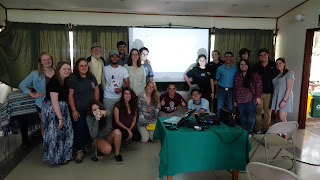Hi there, it's Sydney & Michaela.
On Friday evening, we arrived at La Ensenada, grateful for the wifi and indoor cabins and showers after the full day of traveling. The common area here is very open, with a lot of flowering plants that have attracted a large number and variety of butterflies. From this common area, when the weather is clear, you can see the Golfo de Nicoya.
La Ensenada is a working ranch, wildlife refuge, and a lodge. The ranch contains big white cattle called Brahman (who you can see as you drive onto the property), horses and produces salt and fruit. The wildlife refuge contains mangroves, sweet freshwater and a line on the Golfo de Nicoya shore as well as over 140 species of birds and other wildlife. Their reforestation program has three steps; a natural return to the forest environment, planting local species and the planting of more exotic species. The refuge is currently 30% covered by forests.
On Saturday, we went to the Mariposas del Golfo to hear a presentation on their sustainable fishery initiative called “Pesca Responsible”. Before this initiative, big companies would, sometimes illegally, use large fishing nets in the Golfo de Nicoya. These fishing nets would take almost all of the fish from the Golfo, leaving the local fishermen without food or a way to make money. The initiative has essentially blocked off an area of the Golfo where fishing with nets is no longer allowed. Inside this area, only fishing by hand is permitted, allowing the locals to still catch fish and allowing the fish populations to rise. This blocked area also contains a mangrove forest, which acts as a nursery for the fish. By protecting this area from overfishing, the locals are allowing the populations to grow and the fish to get larger, which means that the locals can get more money for the larger, more mature fish and the fish can thrive without being overfished. The Mariposas del Golfo are also trying to cut out the middleman during the sell of their fish so that they can get a more fair price on their fish. They also have a butterfly farm in their center, used for education and will eventually be used to sell them. Some of the butterflies make territorial noises.
Saturday afternoon we set 75 Sherman traps along a trail and 10 traps around the garden. We also set 4 camera traps along the trail in the forest, hoping to catch sight of ocelotes, iguanas and coatis. We also set up a trap near a gate in the farm’s fencing with the idea we might see an animal travelling along the length of the fence looking to pass through. Our final trap was set up near a small pond where we might be able to see animals coming in to drink water or possibly even a crocodile.
Early Sunday morning, we set out to check the traps and found four rodents, 2 Cotton Rats and 2 Salvin's Spiny Pocket Mice . This is the most amount of rodents we have caught in one day since we have been in Costa Rica. One of the rodents we caught today also lost its tail during measurements, which has happened a lot this week, despite our careful efforts and Dr. Ribble’s expertise.
Although it seems that there has been just as much rain during our time at La Ensenada, the forests here are classified as a Dry Forest and are very different from the rainforests we saw in the Osa Peninsula. We are visiting during the rainy season so the forests are green with plenty of foliage, but during the longer dry season, the forests here are typically bare and brown as the trees lose their leaves. The trees we have seen have not been as tall and the canopy is not as dense, allowing in much more light than we saw in the rainforest. This allows for the growth of many more small brush plants on the forest floor compared to the relatively bare understory of the rainforest. We also noticed that the leaves on many of the plants are much smaller, possibly because there is less competition for light here. The soil in these types of forests is typically a little deeper than a true rain forest, allowing the trees to put down deeper roots, so we did not notice many examples of the buttresses that were common in the Osa. However, there are still many vines and epiphytes growing on the trees.




No comments:
Post a Comment